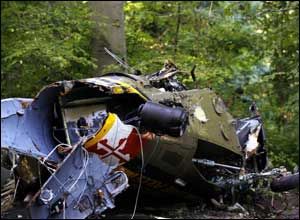By Robert Little
The Baltimore Sun
 AP Photo |
PRINCE GEORGE’S COUNTY, Md. — In a move that could reduce the number of medevac flights in Maryland, state emergency medical officials announced yesterday that ambulance teams will be required to consult with doctors before deciding whether flying some accident victims to a trauma center is better than driving them to a local hospital.
The change, in response to a deadly helicopter crash in Prince George’s County about a week ago, won’t apply to victims with obviously traumatic injuries. But the state will stop automatically ordering medevac transportation based on the nature of an accident, as it does with hundreds of flights each year. Emergency workers will now speak with doctors before deciding whether such cases warrant a helicopter flight, said Dr. Robert R. Bass, director of the Maryland Institute for Emergency Medical Services Systems.
Bass also said state officials will appoint a panel of national trauma and emergency medicine experts to assess the state’s emergency medical system and recommend whether other changes are necessary. He said he hopes to have a panel selected in several days, with the goal of completing its report by the end of the year.
Bass said the protocol change is being implemented to address criticism that Maryland too often uses expensive and potentially dangerous helicopters when a ground ambulance might be more appropriate. The practice will be reassessed in several months to determine if it made a difference.
The Sept. 27 medevac flight that crashed in Prince George’s, killing four people, was ordered because of the degree of damage to the vehicle involved in the accident, rather than the injuries themselves. Both patients were awake and alert after the car crash in Waldorf, but the emergency medical crew chose to fly them to the Prince George’s Hospital Center because, under the state’s emergency response guidelines, the 12-inch dent in their vehicle predicted potentially hidden injuries.
The state’s leading trauma surgeon applauded the change yesterday but said he couldn’t be sure it would lead to fewer unnecessary medevac flights. Maryland’s triage guidelines purposely err on the side of getting patients more care than they might require.
“I have trouble overruling someone who is at the scene and can put their eyes on a patient,” said Dr. Thomas M. Scalea, physician in chief at the Maryland Shock Trauma center in Baltimore, the state’s primary trauma center.
“They’ll call, we will have a discussion, and then we will make a joint decision about what is best for the patient,” Scalea said after a news conference yesterday at the center. “But we’ll continue to err on the side of the patient. There are always people who are fine until they land on our roof, and then all of a sudden they are not.”
Some trauma specialists have questioned the nation’s increasing reliance on helicopter transport, particularly in light of studies casting doubt on whether medevac flights deliver patients faster and lead to better medical results. Among the roughly 4,500 patients flown in Maryland last year, nearly half were discharged within 24 hours, suggesting their injuries were not so severe that a ground ambulance could not have offered acceptable treatment.
Dr. Bryan E. Bledsoe, a University of Nevada emergency medicine physician and a frequent critic of what he perceives as overuse of helicopter transport, praised yesterday’s announcement but said he thinks more sweeping change would be appropriate.
Recent scientific studies suggest that using the nature of a crash to predict injuries is unreliable as much as 80 percent of the time.
“The thing is, the whole argument for the use of these helicopters is speed and rapid transport to the trauma center. And this will add time,” Bledsoe said. “I’ve taken calls like that. You might be treating another patient, you might be suturing and have to take your gloves off. Unless someone is sitting there monitoring the radio full time, it could be difficult and time-consuming.
“What needs to be considered is the elimination of mechanism of injury from the protocol entirely.”
Medevac helicopters will still begin the pre-flight warm-up process when a call comes in, but won’t fly to get the patient until the doctor and medic agree that a helicopter flight is necessary. Bass and Scalea estimated the process might add 60 to 90 seconds to response times.
“If there’s any delay, it should be very minimal,” said Bass.
Bass and Scalea spent much of yesterday’s news conference defending Maryland’s trauma system, which has been copied around the world, against what they perceive as criticism related to the recent crash. Both said they support the new protocol and review but said officials might ultimately determine that few meaningful improvements can be made.
“They’re in the rain, in the dark, lots of noise, a dangerous environment - they have to make these decisions very quickly, and they are life-and-death decisions,” he said. “I have no doubt the system we have now has saved thousands of lives.”
Scott Wells, whose 18-year-old daughter, Jordan, survived last month’s crash and is being treated at Shock Trauma, was unaware of any calls for changes to the system. But regardless of the questions about whether his daughter needed to be flown, he said he is grateful for the system that treated her.
“If the mission is saving lives, lives are saved. If the mission is saving money, money is saved,” Wells said.
“I’m not going to say it hasn’t been a nightmare, but her mother and I are just extremely grateful for the pilot and the paramedics that came out to save our daughter, and for everyone at the hospital who is still working to save her.”











